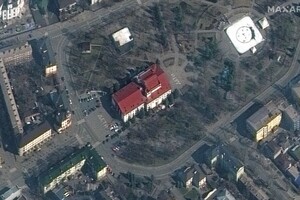However, the death toll may be lower than previously thought.

Russian military fighter dropped to the Drama Theater in Mariupol on March 16 two 500-kilogram bombs that detonated simultaneously. The attack on a civilian facility that killed civilians is a war crime, according to Amnesty International's “Children: Attack on Donetsk Regional Academic Drama Theater in Mariupol” investigation.
Amnesty International has collected testimonies from 53 survivors and eyewitnesses, 28 of whom were in or near the theater at the time of the attack. The researchers also analyzed satellite images and radar data taken immediately before and immediately after the attack; verified photo and video materials from the archives of witnesses and social networks, researched two sets of architectural plans of the theater.
“This attack is an undisputed war crime, and it was committed by the Russian military. As a result of this ruthless attack, many people were wounded and killed. The most likely cause of their deaths was a targeted attack by the Russian military on the civilian population, “said Amnesty International Secretary-General Agnes Callamar.
that immediately after the attack in the Mariupol City Council stated that about 300 people were killed , and The Associated Press reported about 600 deaths in its investigation.
“Evidence gathered by Amnesty International indicates that a large number of residents left the theater shortly before the attack, including on March 14 and 15, when they started working.” green corridors “. And most of those who remained in the theater had the opportunity to be in safer areas of the building, including in front of the theater and the basement, which were protected from direct explosion, “- said in the investigation.
Thus, there were not many people in the field kitchen on the street and directly on the stage and in the front rows of the audience, but most of them died immediately or were seriously injured.
According to the expert physicist, the bombs used should contain 400-800 kg of explosives. According to the available air bombs in the arsenal of the Russian army, their military struck with two 500-kilogram bombs of the same model, with a total explosive mass of 440-600 kg. Most likely, an airstrike struck one of the Su-25, Su-30 or Su-34 fighter jets based at nearby Russian airfields.
The blast destroyed nearby theater walls on both sides of the stage and then broke through the outer load-bearing walls, forming two main areas with debris on the north-eastern and south-western sides of the building.
“It simply came to our notice then. We were 200-300 meters away [when] the explosion happened… I heard a plane and the sound of bombs falling. Then we saw the roof of the [theater] rise, ”said Igor Moroz, a 50-year-old architect who was near the theater when the attack took place.
“I was walking down the street leading to the drama theater… I heard the noise of the plane… but at that moment I didn't pay much attention because [the planes] were constantly flying… I saw the roof of the building explode… He jumped 20 meters and then collapsed … Then I saw a lot of smoke and debris… I couldn't believe my eyes because the theater was a holy place. There were two large “Children” signs, “said Grigory Golovnev, a 51-year-old businessman.
Many respondents told Amnesty International that they saw bloodied bodies and torn body parts, including legs and arms, in the ruins of a destroyed building. after the attack.
The theater, located in the Central District of Mariupol, was used at the beginning of the war as a humanitarian headquarters for the distribution of medicines, food, water, as well as a collection point for people hoping to evacuate through the green corridors. The bright red-roofed theater building itself was separated from other buildings by a 100-meter green area and was the city's most recognizable cultural monument.
None of the 28 survivors of the attack with whom Amnesty International spoke nor did other witnesses near the theater provide any information on the day of the attack, indicating that the Ukrainian military used the theater as a base for military operations, a place to store weapons, or a place to launch attacks.
“The civilian nature of the theater and the presence of numerous civilians were evident even a few weeks before the attack. So it is most likely that the attack on the theater was intentional, and therefore it is considered a war crime, “- summarize human rights activists.
Read also: The occupiers organized a” tour “under red flags to the bombed Drama Theater in Mariupol – video
It should be noted that in mid-April it became known that Russian troops began clearing the rubble of the Drama Theater in Mariupol to hide the traces of war crimes. In particular, the bodies of the dead were taken for burial in a trench in the village of Mangush near Mariupol. At the beginning of the summer, the occupation administration announced that it planned to restore performances in the theater in the fall, which had become a place of death or tragedy for many Mariupol residents.
See the special topic: Stefanishina spoke about the NATO Comprehensive Assistance Package for Ukraine According to her, this is a kind of upgrade of the previous efficiency, which functioned between Ukraine and the Alliance. ZSU liberated Zmiiny Island Now there is a fire, explosions are heard. NATO lacks the collective determination to cross the red line drawn by Putin – Stefanishin on the Madrid summit Ukraine is forced to look for other options to protect national security. The intensity of enemy cyberattacks is not decreasing, although their quality is declining – State Special Communications During the first four months of the war, the occupiers carried out almost 800 cyberattacks. “Wounds We Have Never Seen in Our Lives”: Doctors Tell What Problems They Faced in the First Months of a Full-Scale War and methodological recommendations from the Ministry of Health and the National Health Insurance Fund would facilitate and improve the work of medical institutions in wartime, including on the line of contact? The question is rhetorical.


